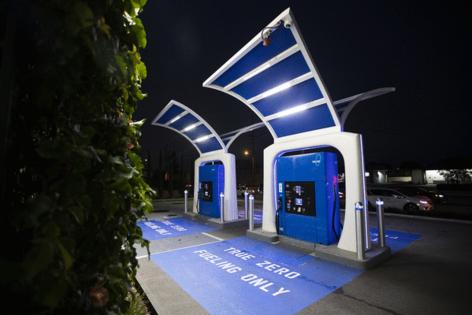Few stations and $200 to fill up: Life on California's 'Hydrogen Highway'
Published in Automotive News
As California’s longtime chief climate regulator, Mary Nichols once championed hydrogen fuel cell cars. Just a few years ago, as the state spent tens of millions of dollars on a planned network of fueling stations dubbed “the hydrogen highway,” Nichols was extolling the 300-mile (480-kilometer) range and quick refueling time of her own hydrogen ride, a futuristic Toyota Mirai.
Today, though, Nichols drives a battery-electric Ford Mustang Mach-E. It too offers 300 miles of range. “I would have no problem driving a hydrogen car again but I don’t know that I would feel like I had to,” says Nichols, who served multiple terms as chair of the California Air Resources Board before stepping down in 2020. “Right now, I don’t think it would be a good bet to assume that there’s going to be a big shift to hydrogen vehicles except for heavy-duty trucks, where being able to move a lot of weight is important.”
Despite billions of dollars of investment, fuel cell cars in the U.S. are disappearing in the rearview mirror, overtaken by battery-electric models and stalled by hydrogen shortages and soaring fuel prices. Last year, drivers bought just 3,143 hydrogen cars in California — the only state that sells them — compared with 380,000 BEVs.
Hydrogen’s proponents aren’t throwing in the towel. Toyota and Hyundai are pushing fuel cell models, albeit at heavy discounts, and Honda just announced a hydrogen hybrid version of its best-selling CR-V. California continues to build new infrastructure. But for drivers and would-be car buyers, the practical experience of going hydrogen-electric is bad and getting worse.
“It’s clear what technology has won in the marketplace,” says David Reichmuth, a senior engineer with the Union of Concerned Scientists’ clean transportation program. “If we want to go as fast as possible to decarbonize, then the plug-in electric vehicle is clearly the technology with the infrastructure available to do that now.”
Fuel cells work by converting compressed hydrogen gas in an onboard tank into electricity that powers the vehicle’s motor. Carmakers started developing them in the 1990s after California passed a zero-emissions vehicle mandate to fight smog. Those efforts accelerated in the wake of the state’s landmark 2006 climate law, which ordered a sharp drop in greenhouse gas emissions.
The first hydrogen car efforts were bespoke — in 2006, I drove a prototype of a hand-built Mercedes fuel cell car that cost $1 million. Then in 2013, California enacted legislation allocating $20 million a year to finance 100 hydrogen stations. Soon Honda, Hyundai and Toyota started selling or leasing hydrogen cars in the only state that offered the ability to fuel them.
In 2018, Governor Jerry Brown set a target of 200 hydrogen stations by 2025, a goal to which the state has committed nearly $257 million. But last year Shell Plc quietly declined a $41 million state grant to build 50 stations, and California scaled back its target to 130 stations by 2027. In February, Shell shuttered six of its seven retail hydrogen stations in the state. A total of 66 stations remain, but 12 have been offline for more than 30 days and others sporadically shut down due to supply shortages or equipment problems.
By contrast, California boasts just over 105,000 charging stations for plug-in vehicles. Battery-electric models accounted for 21% of new car sales in the state last year and Tesla’s Model Y and Model 3 were California’s top two best-selling vehicles.
Even for functional hydrogen fuel stations, downtime is routine. On April 2, for instance, 16 of the state’s 54 stations in operation were closed, according to real-time data from the Hydrogen Fuel Cell Partnership. Southern California, hit particularly hard by the Shell closures, sees about half of its stations go offline on any given day.
...continued
©2024 Bloomberg L.P. Visit bloomberg.com. Distributed by Tribune Content Agency, LLC.







Comments